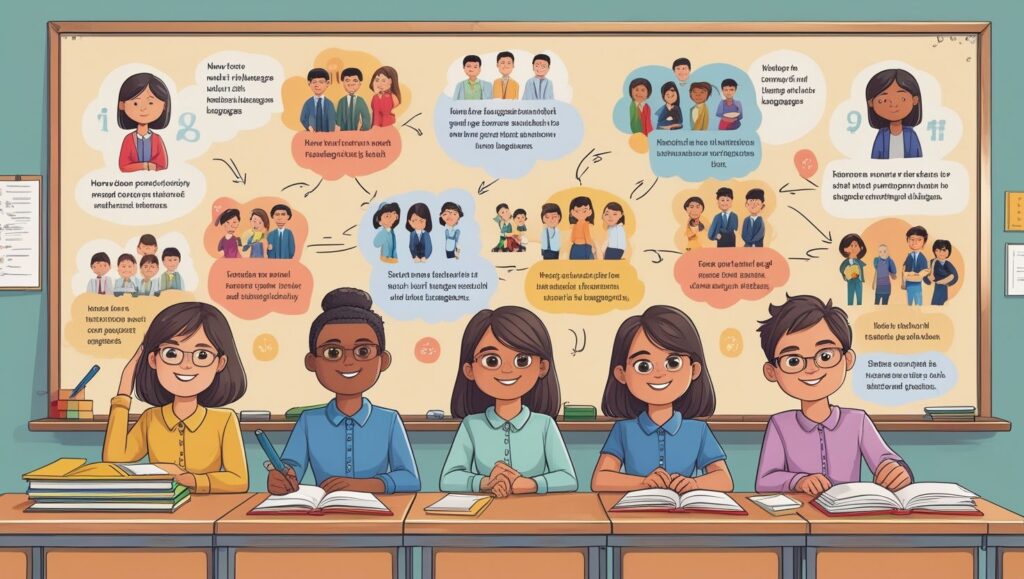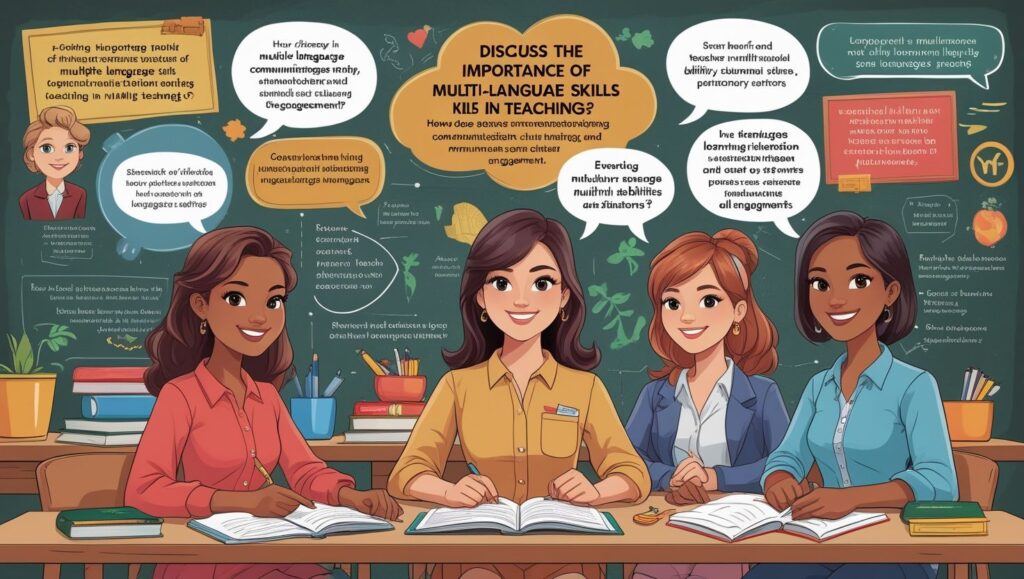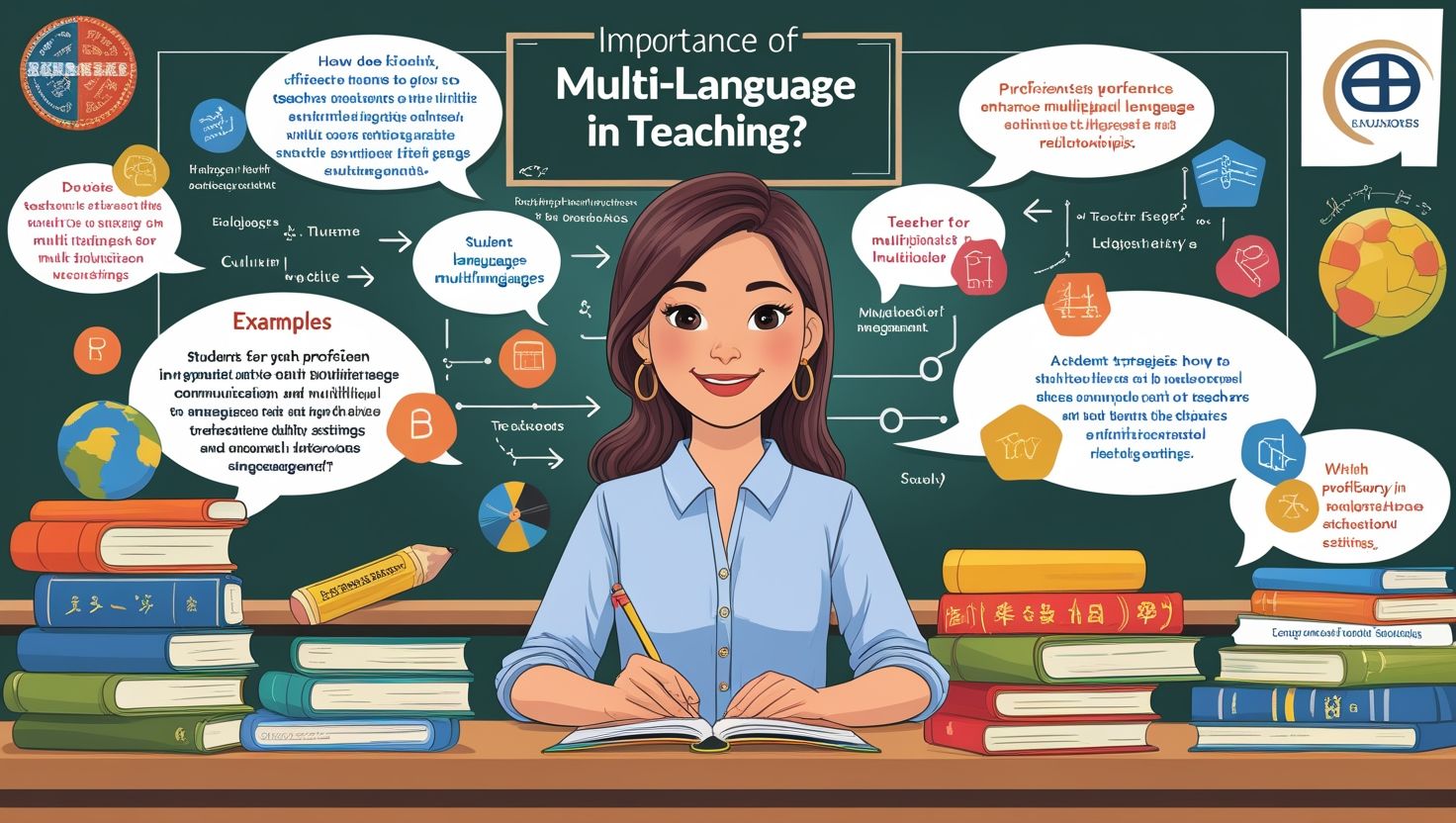Introduction
Multi-language skills in teaching play an essential role in modern education. In today’s classrooms, students come from different backgrounds. They often speak more than one language. Teachers who develop multi-language skills create stronger learning connections. Moreover, they improve communication with diverse learners. In addition, students feel valued when their language is respected. This promotes confidence and motivation. Therefore, teachers with such skills enhance classroom inclusivity. As classrooms grow more diverse, the importance of multi-language skills becomes clear. They help bridge cultural gaps and reduce barriers to understanding.
Furthermore, they prepare students for global opportunities. Language diversity encourages collaboration and deeper thinking. It also strengthens problem-solving skills. Teachers who embrace multi-language strategies foster a supportive atmosphere. Consequently, learning becomes more interactive and meaningful. Although challenges exist, the benefits are far greater. Hence, multi-language skills are not just helpful but necessary in teaching today. They lead to equitable education and ensure students’ voices are heard effectively.
Importance of Multi-Language Skills in Education
The importance of multi-language skills in education cannot be ignored. Teachers often meet students with varied linguistic abilities. With multi-language strategies, learning becomes more accessible. In fact, these skills allow teachers to adapt their lessons. They create an inclusive environment where everyone participates. Additionally, students build cultural awareness through exposure to multiple languages. This awareness leads to tolerance and mutual respect. Furthermore, language diversity in classrooms enriches discussions.
Students learn to appreciate different viewpoints. Teachers also strengthen their own professional skills. They develop flexibility, creativity, and problem-solving abilities. As a result, classrooms become places of collaboration and growth. Moreover, multilingual education prepares students for global realities. International communication depends heavily on language skills. By integrating multiple languages, schools encourage lifelong learning. Teachers also connect more effectively with parents and communities. Therefore, multi-language competence is crucial. It empowers both students and teachers. Ultimately, education becomes richer, broader, and more meaningful.

Role of Teachers in Multi-Language Learning
Teachers play a central role in multi-language learning. They guide, support, and motivate students to embrace languages. In addition, teachers model respect for linguistic diversity. They design activities that encourage communication across languages. By doing so, they create bridges among cultures. Moreover, teachers integrate language skills into daily lessons. They connect subjects with language learning opportunities. For example, they use stories, role plays, or projects. This approach strengthens comprehension and creativity.
Teachers also assess students’ strengths in different languages. Consequently, they provide tailored support for learning. Furthermore, teachers collaborate with colleagues to share strategies. They exchange materials and experiences that enhance teaching. With multi-language awareness, teachers become leaders of inclusion. They help students feel confident and capable. In fact, a teacher’s attitude directly influences learning outcomes. Positive encouragement fosters motivation. Additionally, teachers act as mediators between students and parents. Hence, their role in multi-language education is both instructional and cultural.
Benefits for Students
The benefits of multi-language skills for students are wide-ranging. Firstly, students improve communication abilities. They learn to express ideas in different ways. Secondly, multilingual students develop stronger cognitive skills. Research shows they perform better in problem-solving and memory tasks. In addition, exposure to several languages boosts creativity. Students think more flexibly and explore new perspectives. Moreover, they gain cultural awareness and respect. They become more open to diversity in society. This also reduces prejudice and misunderstanding.
Furthermore, multi-language learning supports career opportunities. Employers value individuals who speak multiple languages. Students therefore gain an advantage in the job market. They also connect with people worldwide. Consequently, they build networks across cultures. In school, multi-language students participate more actively. They collaborate effectively with peers. They also perform better in subjects requiring analysis. Ultimately, multi-language skills help students grow academically, socially, and emotionally. They become confident global citizens ready for future challenges.
Benefits for Teachers
Teachers also gain many benefits from developing multi-language skills. They become more adaptable and flexible in their methods. In addition, they improve their own communication skills. Multi-language teachers can reach diverse learners more effectively. Consequently, classroom management becomes smoother. They can clarify instructions in more than one language. Moreover, teachers build stronger relationships with students and families. They gain trust by respecting cultural identities.
Furthermore, multi-language teachers expand their professional opportunities. Schools and institutions highly value their abilities. They may access roles in international education. In addition, teachers broaden their perspectives. They learn from students’ cultural and linguistic backgrounds. This exchange enriches their teaching style. Teachers also become lifelong learners. They remain motivated to grow and evolve. Consequently, their classrooms become dynamic and engaging. Multi-language competence enhances their leadership skills as well. It allows them to guide peers in inclusive practices. Therefore, benefits for teachers are both personal and professional.

Challenges of Multi-Language Teaching
Despite benefits, multi-language teaching presents challenges. Firstly, teachers may face a lack of resources. Textbooks or materials in multiple languages are often limited. Secondly, time constraints make it difficult to include extra strategies. Teachers already manage heavy workloads. Moreover, not all teachers have formal training in multi-language teaching. This creates gaps in implementation. In addition, classrooms may include many different languages. Meeting every student’s needs becomes complex. Teachers may struggle to balance fairness. Furthermore, some schools may not prioritize language diversity. Limited support reduces teachers’ efforts. Parents may also have concerns about academic progress.
They may fear that learning multiple languages delays achievement. Additionally, teachers may face assessment difficulties. Measuring progress across languages is not always clear. Despite these obstacles, solutions are possible. With training, support, and technology, challenges can be reduced. Teachers must remain patient and innovative. Therefore, while difficulties exist, they are not insurmountable.
Strategies for Effective Multi-Language Teaching
Effective strategies can make multi-language teaching successful. One approach is using visual aids. Pictures, charts, and videos help all students. Another method is group work. Students collaborate and share language strengths. Moreover, teachers can apply code-switching strategically. They switch languages to clarify ideas. Additionally, project-based learning enhances participation. Students explore topics using multiple languages.
Teachers can also integrate technology. Translation tools and digital platforms support understanding. Furthermore, storytelling connects languages and cultures. It builds engagement and memory. Teachers should also encourage peer tutoring. Students help each other learn across languages. In addition, regular feedback ensures progress. Teachers monitor growth and adapt methods. Professional development is equally important. Training workshops prepare teachers with new techniques. Schools must also provide supportive environments. They should encourage language use beyond classrooms. Therefore, strategies require planning and creativity. When applied well, they transform challenges into opportunities.
Role of Technology in Multi-Language Learning
Technology plays a major role in multi-language learning. Digital tools support teachers and students effectively. Translation apps, for example, reduce communication barriers. Moreover, online platforms offer multilingual resources. Students can access videos, articles, and lessons in many languages. In addition, technology encourages independent learning. Learners practice at their own pace. Interactive apps make language practice engaging. Furthermore, teachers use technology to create inclusive lessons.
They design multimedia presentations that appeal to all learners. Online collaboration tools also connect classrooms worldwide. Students exchange ideas with peers in other countries. This builds real-world communication skills. Moreover, virtual reality enhances cultural immersion. Students explore different environments while learning languages. Teachers also benefit from online training programs. They gain strategies and resources easily. However, challenges include access to devices and internet. Despite this, technology remains a powerful tool. Therefore, integrating digital solutions strengthens multi-language education.
Future of Multi-Language Skills in Education
The future of multi-language skills in education looks promising. As globalization continues, demand for language diversity will grow. Schools will increasingly recognize its importance. Moreover, multi-language teaching will become a core skill. Teachers will be trained to embrace it from the start. Technology will also play a bigger role. Advanced tools will simplify translation and communication. Additionally, schools will create more bilingual or multilingual programs. Students will have opportunities to master several languages.
Furthermore, cultural exchange will expand. Students will collaborate internationally more often. This will prepare them for global careers. Teachers will continue to develop innovative strategies. They will adapt to diverse and changing classrooms. Governments may also support language policies. Investment in resources will increase. Therefore, multi-language skills will not remain optional. They will become essential in education systems worldwide. Ultimately, the future of teaching will be shaped by linguistic diversity and inclusion.
Conclusion
In conclusion, multi-language skills in teaching are essential for today’s classrooms. They create inclusive environments and promote student success. Teachers with such skills support diverse learners effectively. Moreover, students benefit academically, socially, and culturally. Teachers themselves gain professional growth and stronger communication. Although challenges exist, strategies and technology provide solutions. With dedication, teachers can overcome obstacles. The future of education will depend on language diversity.
Schools will need to adapt to global realities. Therefore, investing in multi-language teaching is crucial. It ensures equality and prepares students for international opportunities. Furthermore, it builds bridges across cultures and communities. Ultimately, multi-language skills enrich the entire educational process. They transform classrooms into spaces of understanding, respect, and growth. Teachers who embrace these skills lead the way toward meaningful learning. Hence, multi-language education is not just a trend. It is a necessity for a brighter and more connected future.

hyzq71
ev39tt
When I originaly left a comment I appear to have clicked the -Notify me when new comments are added- checkbox and from
now on whenever a comment is added I receive four emaols with
the same comment. Perhaps therre is a means
you are able to remove me from that service? Appreciate it! https://Glassi-Greyhounds.Mystrikingly.com